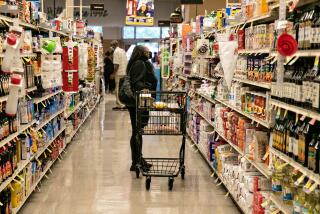Are Supermarket Prices Lower in S.D. Than L.A.?
Are supermarket prices in San Diego lower than those in nearby Los Angeles County?
Yes, no and maybe, according to supermarket executives, federal government statistics and grocery industry observers.
Those who believe San Diegans pay less for their groceries point to ever-increasing competition among retailers, the price-slashing policy employed by the now-defunct FedMart discount grocery stores, and the fairly recent arrival of Ralphs Grocery Co.
Ralphs and Food Basket have accepted slimmer margins in their San Diego stores in order to gain and maintain market share, executives at those chains acknowledged.
But other grocery store spokesmen maintained that price breaks are not possible, given the fairly standard cost of goods sold in supermarkets, San Diego’s high utility bills, ever-increasing real estate costs and uniform labor contracts that cover supermarket chain employees across Southern California.
“On average, we don’t believe that prices in San Diego are measurably lower than in Los Angeles and Orange County,” said Bonnie Lewis, a Los Angeles-based spokeswoman for Safeway, which operates 44 stores in San Diego County.
Overall grocery store prices in San Diego might be “a trifle lower than in Los Angeles but we’re not talking about much,” added Stu Rosenthal, a Los Angeles-based marketing executive with Vons, which operates 30 stores in San Diego.
Nevertheless, executives and industry observers agreed that savvy consumers around the country can trim food bills by paying close attention to what they buy and where they buy it.
But a grocery industry trade magazine editor suggested that less-savvy consumers who spend $50 on groceries each week “wouldn’t find more than a $3 or $4 difference” on the same items at various San Diego grocery stores.
The argument that prices are lower in San Diego gained validity in 1982 when a U.S. Department of Agriculture survey indicated that San Diegans enjoyed lower prices than just about anywhere else in the country, including Los Angeles.
However, that same survey suggested that it is difficult to make comparisons between Los Angeles and San Diego “because there’s as much of a (price) variation within stores in San Diego County,” according to Charles Handy, who conducts economic research for the USDA.
The federal Consumer Price Index also indicates that prices in San Diego might be lower than those found in Los Angeles. Price increases for food eaten at home in San Diego have lagged the increases in Los Angeles by a slight margin, according to statistics generated by the U.S. Department of Labor’s Bureau of Labor Statistics.
However, it is difficult to determine which county enjoys the lowest prices because “so many grocery store price comparisons are rigged because (supermarkets) pick items so they can win,” said one grocery store executive.
Grocery store operators do agree that San Diegans benefit from living in a competitive market that generates competitive pricing.
That pricing structure was created in part by the “very competitively operated” but now-defunct FedMart chain, according to Larry Mabee, president of San Diego-based Big Bear, which operates 19 stores in San Diego.
Ralphs Grocery Co. grabbed FedMart’s 13 San Diego locations and, after remodeling them, gained an immediate presence in San Diego County. The Compton-based company then crafted an extremely competitive pricing attack to wrestle market share from existing competitors.
“San Diego enjoys the lowest prices in America and we feel that we’re partially responsible for that,” said Al Marasca, Ralphs’ executive vice president of marketing.
After Ralphs arrived with its low-price strategy, Food Basket, a subsidiary of El Monte-based Lucky Stores, followed suit and trimmed margins to protect the market share held by its 25 Food Basket stores.
“We didn’t want to lose our edge in San Diego,” said Lucky Stores Vice President Dick Frederickson.
Consequently, for a “substantial period of time” San Diegans enjoyed lower prices than friends and relatives who shopped at Ralphs and at Lucky stores in Los Angeles, Frederickson said.
Not surprisingly, store operators have tried to push prices back up to bolster their margins.
Today, the “average margin for our stores in San Diego is still lower than it is in Los Angeles,” Frederickson said. “But at least our rate of return is now at a livable rate.” Ralphs has stuck to a pricing structure that remains 4% to 5% lower than in Los Angeles, according to Marasca.
However, Ralphs accepts double coupons on some items in Los Angeles, a cost-cutting practice it discontinued in San Diego because of its closer margins, Marasca said.
COMPARING SUPERMARKET PRICES
ITEMS VONS SAFEWAY RALPHS L.A. S.D. L.A. S.D. L.A. S.D Mayonnaise, 32-ounce jar $1.79 $1.74 $1.79 $1.89 $1.76 $1.72 Flour, 5 pounds $.84 $.99 $1.36 $.99 $.89 .79 Eggs, AA (large), one dozen $1.27 1.37 $.99 $1.19 $1.28 $1.32 Bacon, 16 ounces $2.39 $2.09 $2.32 $2.02 $2.29 $1.98 Cube steak, 1 pound $2.29 $2.76 $2.59 $2.59 $2.69 $2.36 Facial tissue, 175-count $.99 $1.06 $1.11 $.99 $.95 $.99 Soap, 5-ounce bar $.59 $.64 $.71 $.69 $.68 $.69 Beef loin top sirloin, 1 pound $3.19 $3.29 $3.02 $2.99 $1.99 $2.79 Orange juice, 12-ounce can $1.19 $1.39 $.99 $1.19 $1.16 $1.19
Source: California Public Interest Research Group, which completed supermarket price surveys in Los Angeles in November and San Diego in March. Items, which are the same size and brand, were selected at random from Calpirg’s shopping studies. Produce items were not compared because of seasonal differences.
More to Read
Inside the business of entertainment
The Wide Shot brings you news, analysis and insights on everything from streaming wars to production — and what it all means for the future.
You may occasionally receive promotional content from the Los Angeles Times.










